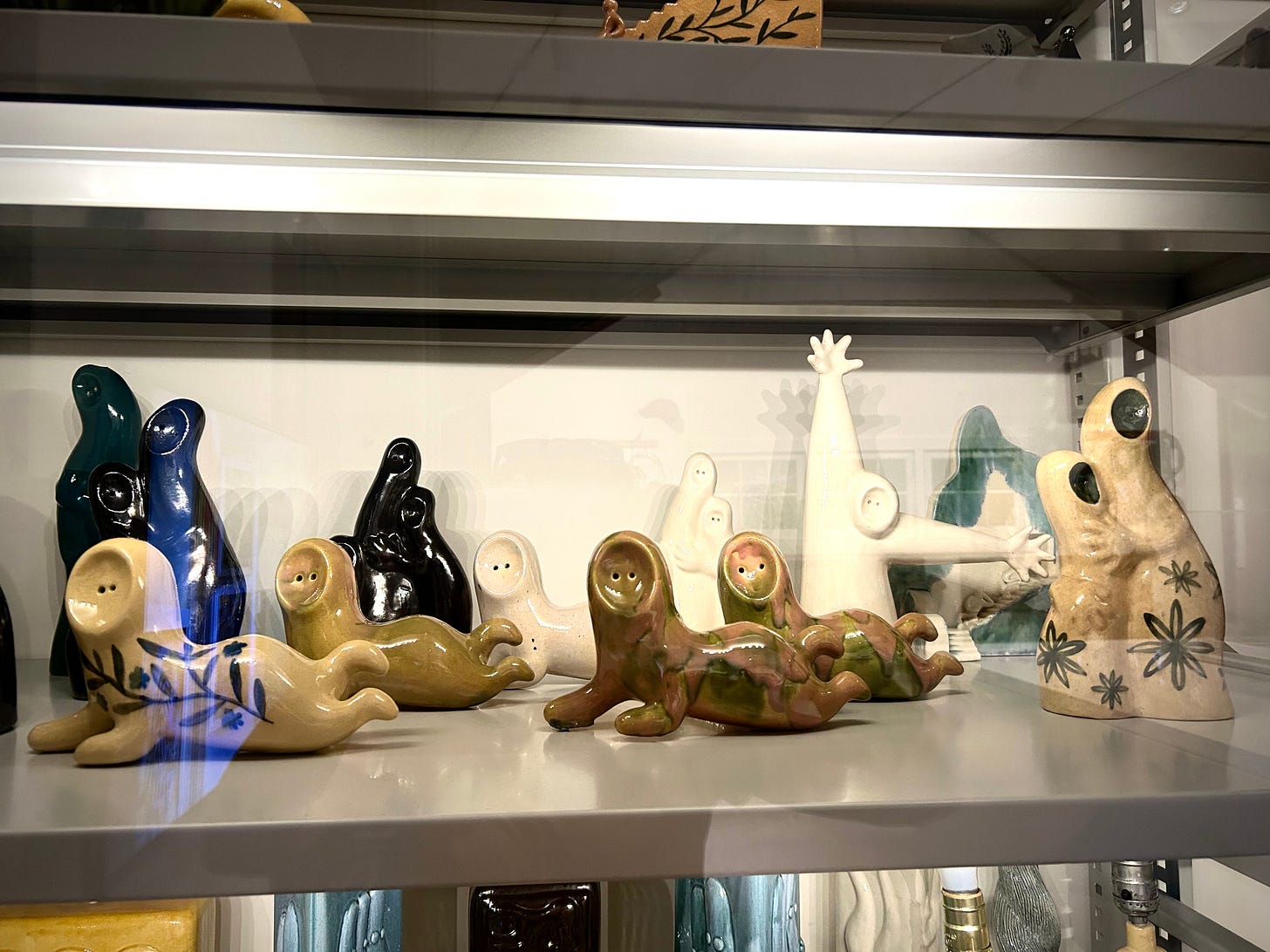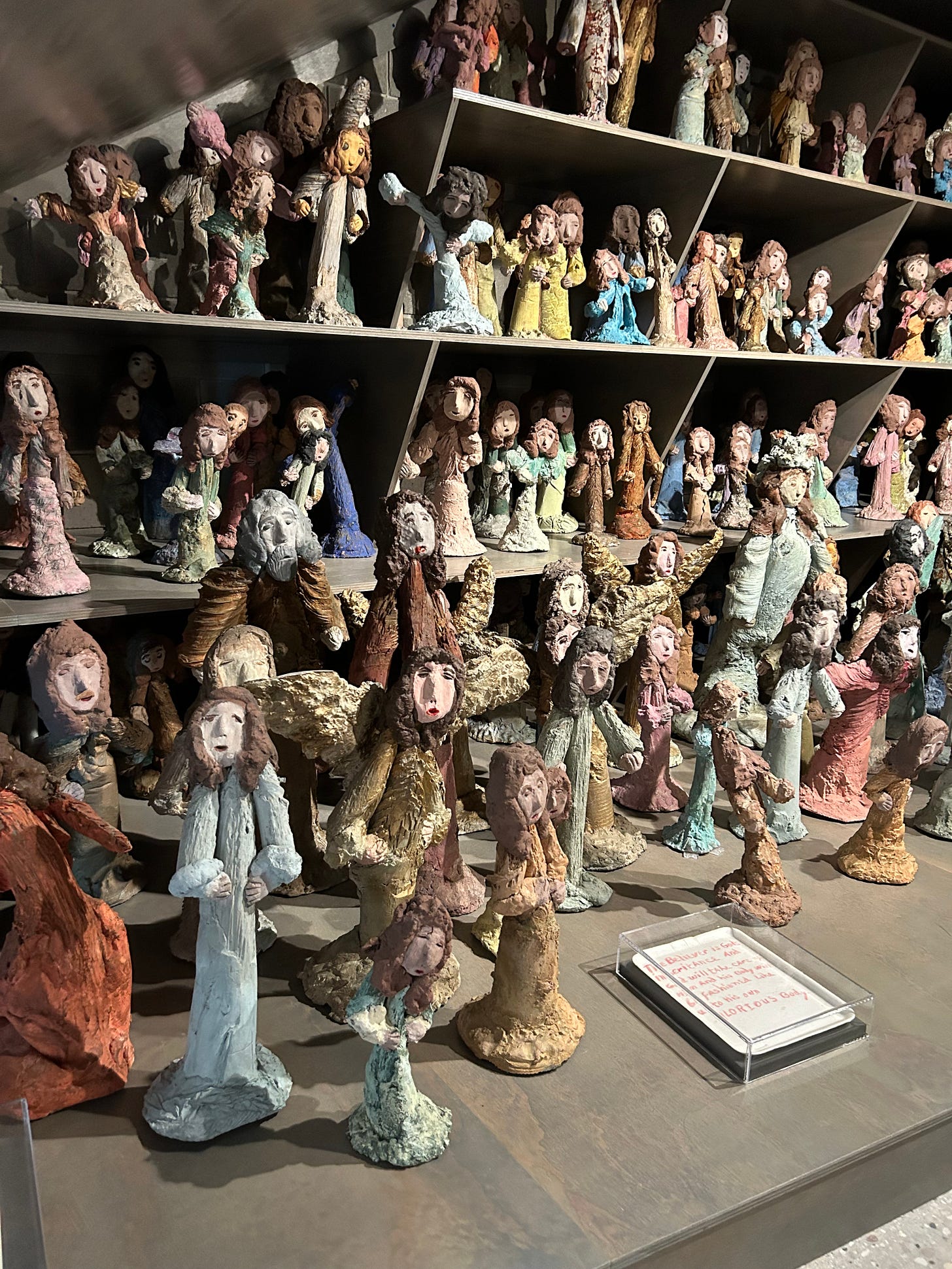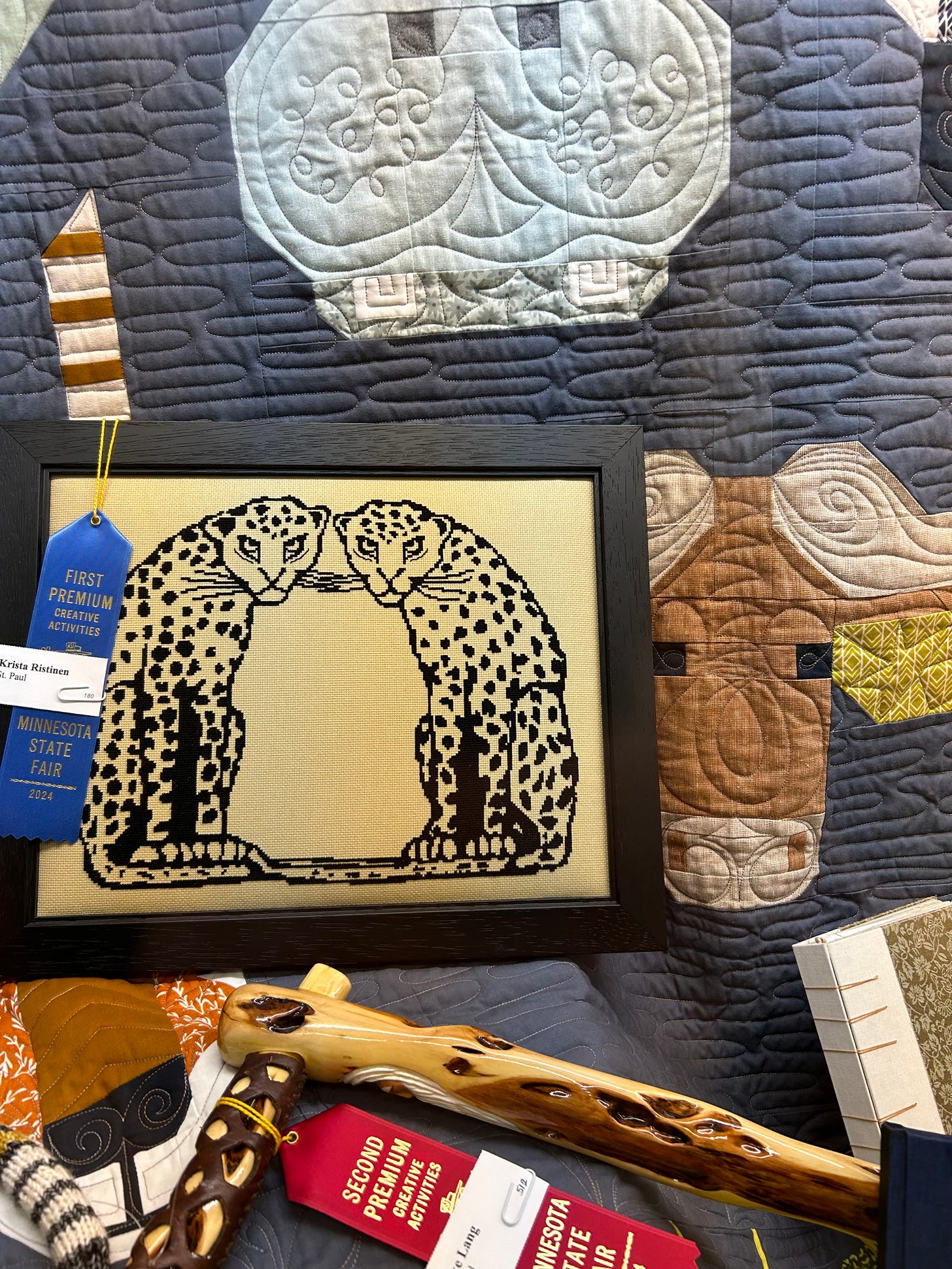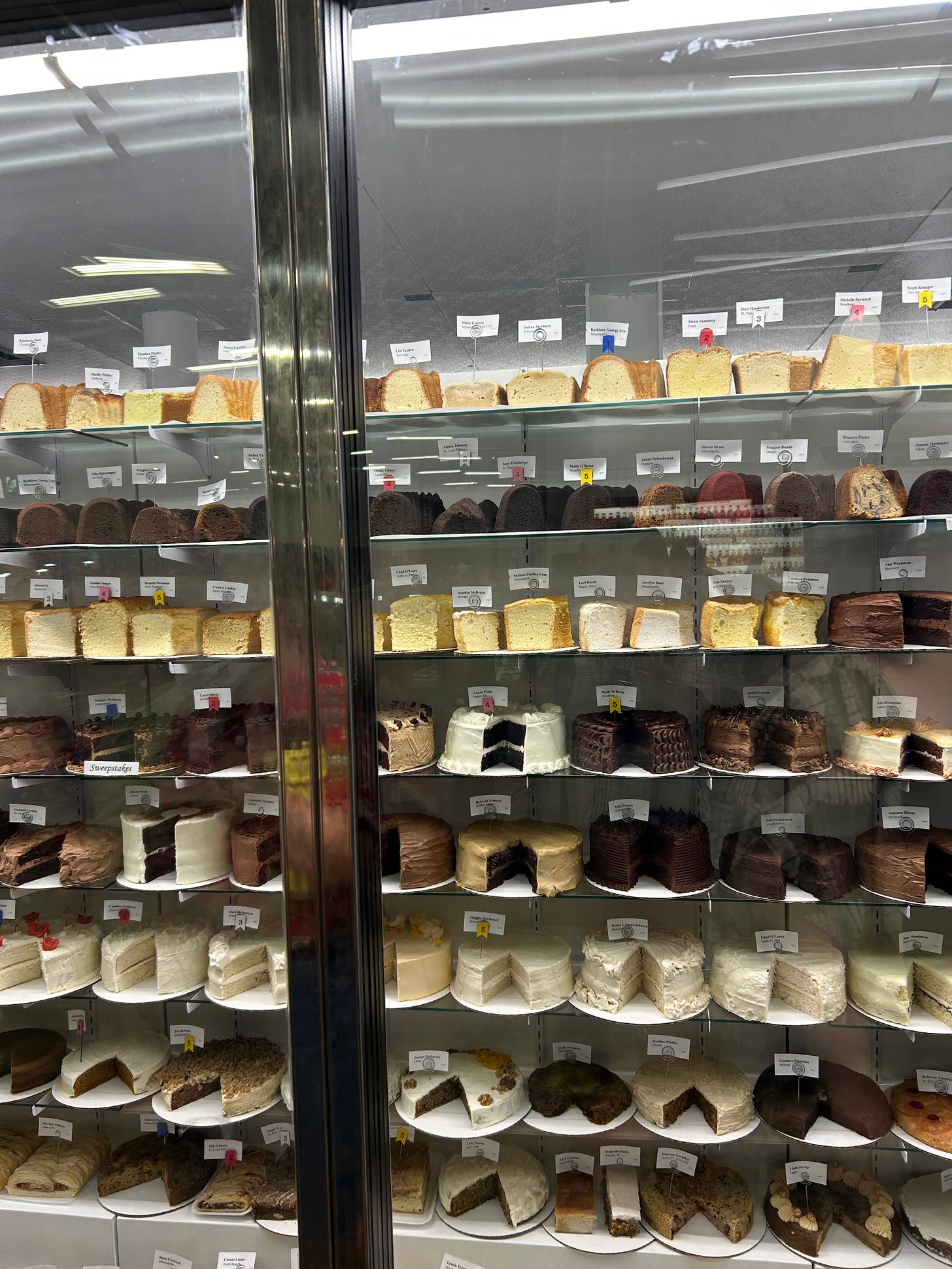I.
The shelves—vertical, industrial, mounted floor to ceiling on steel tracks—look like they should slide like patio doors. What a wonderful idea, you think, accepting the invitation to lose yourself in a maze of your own arranging, flip slowly through the giant pages of a grandly obsessive life.
But the shelves don’t move. (I push and push, and then a sign explains to me that it is futile.) Instead, you see only the edges of what they hold: for instance, a skull. On the next canvas: another skull, same shape but different colors. Another—unclear from this angle, but probably also skull. On other edges of the rooms, other kinds of patterns reverberating from other minds, archived within the orderly dark.
Not everything is filed away like this, but much of it has to be. The Art Preserve contains thousands of objects in total, produced by just a few dozen often-isolated visionaries and assembled under a commitment to preserve “artist-built environments.”

You, the visitor: you can’t see it all. You don’t get to see it all. In the moment of the shelves not moving, this limitation strikes me as not just logistical but purposeful, spiritual. I imagine the archivists themselves sworn to certain practices, a system to ensure that though the Preserve may own very nearly everything a person made, no single other person may grasp the whole of it.
Later, I walk into the library of Stella Waitzkin, transported from the Chelsea Hotel: shelves upon shelves of books sealed forever in resin.
II.
I walk in with a headache: Wisconsin summer pollen, pressure of low clouds. Some of these oeuvres do seem to spring from a constant pressure in the head, forcing out language onto whitewashed boards, chicken-bone towers shellacked in midcentury pastels, plaster figures from the book of Exodus.
Others feel perhaps more bodily: the kinetic satisfaction of gluing sequins into painted grids, or carving palm-size versions of every animal to exist and then some that do not. A lucky one or two seem produced from what most of us would kill to have: an oceanic supply of pure creative energy, unbound by worries about reception, perfection or other mortal concerns. See Mary Nohl, who preferred to describe herself simply as “a woman who liked tools.”
III.
Here is one dream of artistic success. After your death they open the contents of your mind. They roll the stone away and something gleams, alive to your discoverers as it was not alive to most of your contemporaries.
One display in the Eugene Von Breunchenhein rooms recreates a dimly lit attic nook holding a pile of handcrafted treasures: golden eggs and anguished masks and a score of ceramic crowns. In isolation you could take it for the burial chamber of an ancient king, these artifacts the sole evidence of a civilization sunk deep into obscurity. Except, miraculously, such caches lie around every corner at the Art Preserve. Palaces still stand around you, though the rules and customs of the civilizations remain obscure.
IV.
And there really are palaces, almost. The houses! Photographed mostly, but sometimes partly reconstructed right there in the museum, as with “Rhinestone Cowboy” Loy Bowlin’s Beautiful Holy Jewel Home. Can you really live so comfortably among the spilled contents of your imagination? So love the work of your own hands? The Art Preserve says yes.
The houses, and then the grounds. Some of the artists saw their endeavors as a public good, welcoming Sunday drivers and curious roadtrippers to walk the garden paths of their obsessions. The armies of figures that these artists have conscripted into reality are peacetime armies. They smile as they advance. But some of the Sunday drivers must have felt it eerie anyway, to find their neighbors so unexpectedly numerous.
Other creators refused the attention their expanding kingdoms drew. Some insisted that their work was not art at all. Which made it what, then, in their eyes? A shameful compulsion? Or one half of a private conversation with God?
IV. Life & Works
Assembled from descriptions in the Kohler Art Preserve catalog
A carpenter by trade
Solitary by nature and uninterested in farming
Began to whittle while working as a shepherd in his native country
Met his minimal needs by doing mechanical odd jobs
Tended his neighbors’ lawns, cleaned the streets, and picked up discarded objects
Farmed and scrapped metal to get by
Cutting grass, building roads, loading lumber
Worked as a florist and later at a commercial bakery
Waitressing, singing, and working on an assembly line for Boeing
Conducting tea-leaf readings and engaging in prostitution
Sentenced to three years in prison for breaking and entering
Little is known about the life
Retiring from the railroad in 1976
Depressed and bored, he transformed himself
After a stay in a local hospital
While working as a road inspector near Chandigarh
Rejecting the conventionality and materialism of her home life
Began to save odds and ends, including entire cars and decommissioned airplanes
Relying on his skills as a blacksmith, cabinetmaker and railroad worker
His professional bricklaying experience gave him a strong understanding of the material
Inspired by his research into formal English gardens, Swedish architecture, and a local ice sculpture carving competition
It seems whatever I tried to make would fall down, so I wrote to Father Doberstein
At some point on his property he began creating
Inherited an uncle’s house and started to fill a large shed
After her parents died, she began to alter the lake house
Covering every part of her family property
Inside the house, almost every surface is adorned
Pleased with the results, he similarly embellished the entire exterior
His fence, house, yard, and several outbuildings overflowed
Once the museum was full, he turned to the grounds
Intended as a family memorial
This endeavor would occupy the artist for the next thirty years
Over six hundred carvings of animals, real and mythic
Most of the works have eyes—crudely slashed holes—while others have tongues
Though there is no indication that their primary purpose was to protect his crops
Eventually, a few thousand figures in immersive scenes filled the rooms
He continued to add to his wooden garden
When her husband fell ill and she could no longer lead tours, she painted explanations of the scenes
Diagrams of the components, documenting the variety of stones and rocks she had included
Anchored by a series of paintings installed stacked or facing down to the earth
Later piled in stacks that stretched toward the ceiling of his studio
Later covered the floor, furniture, undersides of rugs, and even appliances
It is unknown how many he ultimately made
Forever fearful that his garden would be destroyed
Family members bought and sold pieces from his yard
Despite his wishes to burn the dolls, she maintained the site until her death
His whereabouts remain unknown
The collection remains intact and densely installed
VI.
The monoculture seems to come and go in waves. Right now the tide seems high to me, fluency in Taylor Swift and TikTok trends and reality TV being generally assumed. Sometimes I think about it crashing, and a consequent resurgence of the small-time, the hyperlocal. Which is a little silly for several reasons, one being that the small-time has been here all along.
Some of the art I have loved most vividly lives only on burned CDs, in chapbooks, on small stages long dismantled. And this is not such a bad place to wind up as a creator, in some fond corner of a couple dozen people’s memories. I think about the little bits of confetti that I’ve dispersed into the world: the choruses that might be occasionally hummed, the snippets of reviews that live on book jackets, the odd image from a poem or essay that may surface like a slogan for a long-discontinued product, unmoored now from material reality.
I think about the hundreds (thousands?) of meticulous, idiosyncratic works displayed at the Minnesota State Fair. This year my wife and I found ourselves in the Creative Activities pavilion for the first time, and in that fluorescent-lit crowd I felt the reverent hush of the Art Preserve waft back up around me. Here too was the dizzying press of fathomless minds and busy hands. They wanted the world to recognize their efforts in categories like International or Historically Inspired Rug and Freehand Painting on Porcelain—Insects and Miniature Figure, Mounted on Animal and Fruit or Vegetable Doll (not made from produce, must have head, arms and legs). The glass cases went on and on and on. We tried to see them all.
All this and the stacks of cakes, pies, jellies, pickles gave the impression of goods being assembled for the pyramid of a pharaoh greater than any known to history. For the last two weeks of summer we could all be that pharaoh. We could gaze dumbstruck upon the vast wealth ordinarily bound up inside each other, before the cakes were tossed uneaten and the lights turned out.




